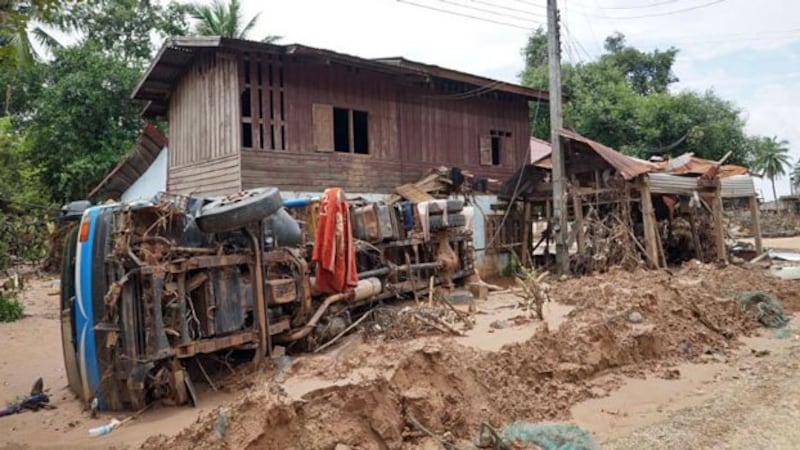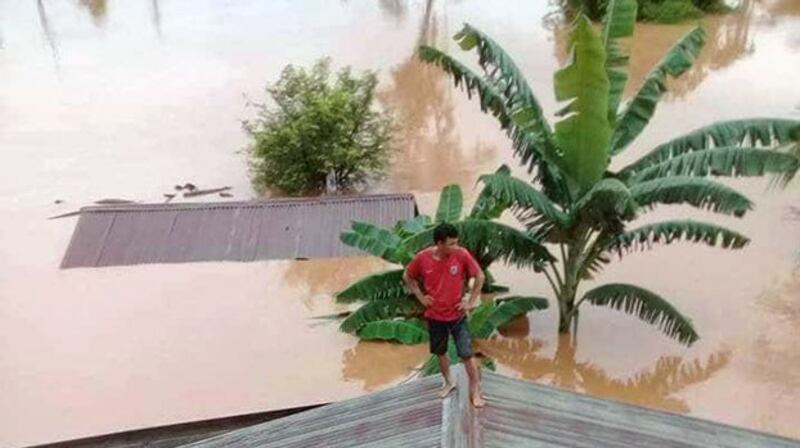On the third anniversary of a hydropower dam collapse that caused deadly flooding in southern Laos, villagers in six communities hit hardest by the disaster say they are still facing hardship due to unsuitable land on which to grow crops year-round, a lack of permanent housing, and the near end of monthly rice supplies and financial allowances from the project's builder.
On the night of July 23, 2018, billions of cubic feet of water from a tributary of the Mekong River poured over a collapsed saddle dam at the Xe Pian Xe Namnoy hydropower project following heavy rains in Laos’ Champassak province, sweeping away homes and causing severe flooding in villages downstream in Attapeu province.
The disaster left 71 people dead and displaced 14,440 others when it wiped out all or part of 19 villages.
About 3,600 people living in temporary shelters in Attapeu province’s Sanamxay district say they are still struggling to recover with inadequate support from the dam’s developers and the Lao government. They reside in the villages of Thaseangchanh, Hinlat, Samongthai, Thahinh, Mai, and Dongbak.
Besides a lack of permanent housing and a drop-off in food and cash subsidies, the villagers say they do not have access to enough fertile lands provided by provincial authorities to be able to make a living growing rice — a staple food in Laos — which further threatens their food security situation. The floods destroyed their previous farmland.
“Before the dam collapse, I produced 280 sacks of rice during the rainy and dry seasons, said a villager who declined to be named.” Each sack weighed 35 to 42 kilograms [77-93 pounds].”
After the harvesting season he had at least 10 tons of rice, but after the dam burst, he could only harvest about 100 sacks of rice, or 3.5 tons, from his paddies, the villager said.
Another farmer said he can only grow rice in the dry season but not during the rainy season because there is too much mud still in areas affected by the flood waters three years ago.
Some villagers plowed their plots of farmland to plant rice in April, but the plants die due to a lack of sufficient rainfall and grass growth that covered the paddies, the villager added.
Another villager said he used to be able to produce 200-300 sacks of rice annually and had a surplus of the food commodity before the disaster, but that after the flooding he could produce only six sacks during the last harvesting season.
Though some farmland can be used for growing rice, other land cannot, so that some farmers cannot grow it at all, he said.
“We do not transplant the rice but we grow it by throwing its seeds because the new farmland now cleared is not ready for growing rice yet,” the villager said.
A third villager said he used to produce about seven tons of rice per year, but now he manages to harvest just under two tons because the farmland given to him by authorities is not suitable for rice paddies.
“Farmland on higher ground cannot retain water because the ground has not been flattened, so it is not ready for growing rice,” he said.
The farmer also said that some families now do not even have farmland, though in the past they each had between two and eight hectares of land to grow on.
“My previous farmlands were fertile and could be easily plowed because they were wetlands,” he said, adding that he used to make 10 million kip (U.S. 1,029) from selling rice per year, but now only produces 10 rice sacks.
A fourth villager had the same complaint, saying that some farmers had to lease arable land on which to grow rice and vegetables.
“People have to make arduous efforts to make a living by leasing lands in other areas to grow cassava because the government does not pay attention to us,” he said.

‘Many cannot cultivate their old fields’
Leth Sayaphone, government of Attapeu province said that officials have allocated agriculture land to the affected villagers according to the number of family members in each household in accordance with the country’s Land Law, while they rehabilitate the original land.
He suggested that some families may not have the money to invest in agriculture production, but added that the provincial government would grant them new plots if they were dissatisfied with what they were allocated.
“Actually, the new plots of land allocated are fertile, though they are soft and covered with mud,” he said. “We still have 100 hectares of land set aside for allocations to the villagers. No problem, if people do not like it, then we will allocate a new plot to them.”
Provincial officials also have repaired most irrigation systems in the affected area so farmers can grow rice throughout both the rainy and dry seasons, Sayaphone said.
The villagers’ living conditions cannot be restored in three to four years because of the lack of permanent arable land they need to ensure they have livelihoods, analysts said.
The provincial government has not been able to solve the problems of the communities, especially in relation to the agricultural land that they need for their livelihoods, said Ian Baird, a geography professor at the University of Wisconsin-Madison who previously worked for many years on development projects in Laos.
“This is because a lot of mud was deposited on their old lowland rice fields, and this has made it difficult to work that land. Many cannot cultivate their old fields at all,” he said.
The restoration of the lowland rice fields is crucial for the villagers’ livelihoods because they are used to getting most of their income from producing rice, which can’t be grown in the highlands, Baird said.
Though they have been encouraged to cultivate sugar cane and other crops in contract farming arrangements on the highland plots they have been given, the villagers have not done so because they are concerned they will not be able to produce as much as anticipated, and ultimately lose money after the cooperating companies deduct their costs.
“It is crucial that there be a clear plan to rejuvenate the agricultural land first. Without dealing with agricultural issues, it will not be possible to restore people’s livelihoods,” Baird said.
Others criticized the hydropower dam company for not yet providing permanent housing for all those displaced by the disaster.
“The company in charge of building houses told us the construction would be completed soon, but in reality it has not. I do not think the houses will be completed in 2021,” said a villager living in a temporary shelter.

‘Where their priorities are’
Bruce Shoemaker, an independent researcher who lived in Laos during the 1990s and worked for several NGOs, said that Xe Pian Xe Namnoy Power Co., Ltd. (PNPC), the company that built the dam, has not made good on pledges to provide proper shelters for the villagers.
PNPC is a consortium of South Korean companies SK Engineering and Construction and Korea Western Power, Ratchaburi Electricity Generating Holding of Thailand, and Lao Holding State Enterprise (LHSE). The company previously has said that it could not make the payments to the villagers because of its own financial difficulties.
“The company claims they do not have enough workers or materials or budget to rebuild the housing in a timely manner,” Shoemaker said. “Yet during this same time period, the company managed to completely rebuild the saddle dam and initiate commercial electrical generation.”
“This shows where their priorities are, and they are clearly not on making amends to those whose lives were destroyed by this company’s irresponsibility,” he said.
Having permanent housing means little without also addressing their livelihoods, he said.
“The villagers need access to fertile farmland and forests, not just housing, if they are going to successfully recover from this disaster,” Shoemaker said.
PNPC is building 700 permanent houses at the cost of nearly U.S. $25 million for the villagers, but they are not yet completed.
Leth Sayaphone, Attapeu’s governor, acknowledged that the company has rebuilt the dam and is running commercial operations, but said that the house construction had been delayed due to coronavirus pandemic lockdowns and because builders could not import some construction materials from neighboring Thailand.
“Villagers’ livelihoods are almost restored, though over 100 houses have still not been constructed and more than 500 houses are almost completed,” he said.
PNPC has also neglected to fulfill other obligations to the affected villagers living in temporary shelters, including the monthly distribution of 20 kilograms of rice and a 250,000 kip (U.S. $26) living and food allowance per person.
The villager living in a temporary shelter said that PNPC has stopped giving people in the affected communities the promised amount of rice and living allowances since earlier this year.
“The officials told us they will cut the rice from 20 kilos to 12 kilos as of February,” he said.
Another villager told RFA that some of the men work construction jobs to make money because they have not received their rice and living allowances for five to six months.
The rice distribution has been delayed because PNPC does not have the money to meet the needs of the affected villagers, said Sayaphone.
“We have just had rice and plan to distribute it to the villagers,” he said, adding that the provincial government does not have additional funds to pay the villagers their monthly allowances in advance.
Laos has built dozens of hydropower dams on the Mekong and its tributaries and is building about 50 more under a plan to become the “Battery of Southeast Asia” and export the electricity they generate to other countries in the region, mainly Thailand.
The Lao government sees power generation as a way to boost the country’s economy, but the dam projects are controversial because of their displacement of villagers without adequate compensation, environmental impact, and questionable financial and power demand arrangements.
Reported and translated by Ounkeo Souksavanh for RFA’s Lao Service. Written in English by Roseanne Gerin.
